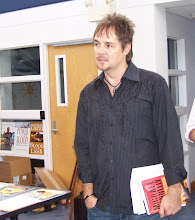
Back in November at the Miami Book Fair, while telling Dennis Lehane how much his books have meant to me, I asked him if he had seen Martin Scorsese’s adaptation of his novel, “Shutter Island.” He told me he had and that it was a masterpiece.
I couldn’t agree more.
At 67, Martin Scorsese is at the height of his powers as a filmmaker.
And for the third time—three for three—Mr. Lehane has had one of his novels adapted successfully (the others being “Mystic River” and “Gone Baby Gone”).
It’s rare for an author to have one good film made of his or her work, but three? It’s unheard of. I asked him why he thought he’d been so fortunate, and he said it was because in each case, a true auteur was involved—an artist with a vision to serve as author of the film. In the same way Mr. Lehane is the author of his books, Clint Eastwood was the author of “Mystic River,” Ben Affleck, of “Gone Baby Gone,” and, now, Martin Scorsese of “Shutter Island.” Just as a great novel must have a visionary artist, a great film needs a single-minded director, an alchemist who takes all the disparate elements and makes magic.
It’s 1954, and up-and-coming U.S. marshal Teddy Daniels is assigned to investigate the disappearance of a patient from Boston’s Shutter Island Mental Hospital. He’s been pushing for an assignment on the island for personal reasons, but before long he wonders whether he hasn’t been brought here as part of a twisted plot by hospital doctors whose radical treatments range from unethical to illegal to downright sinister. Teddy’s shrewd investigating skills soon provide a promising lead, but the hospital refuses him access to records he suspects would break the case wide open. As a hurricane cuts off communication with the mainland, while more dangerous criminals escape in the confusion, and the puzzling, improbable clues multiply, Teddy begins to doubt everything - his memory, his partner, even his own sanity.
I have been an admirer of Dennis Lehane since, while doing a book signing for my first novel at Murder on the Beach in South Florida back in1997, Joanne Sinchuck, the store’s owner, recommended I read “Sacred,” which had just come out. It was so good, I had soon read everything he’d written, and have continued to read each new work as it has been published (though I’ve yet to be able to get to his latest “Remains of the Day,” because of deadlines). Of Mr. Lehane’s books I’ve read “Shutter Island” is my favorite just behind “Gone Baby Gone,” but I highly recommend all of his work as some of the very best contemporary crime fiction being written.
With “Shutter Island” the film, what Scorsese has done is take a great novel and do it justice by making it into a powerful cinematic experience. He uses the language of cinema to offer a film that, to me, is more translation than adaptation. It’s faithful to the book in many literal and all spiritual ways.
Sitting in the dark theater watching Scorsese’s “Shutter Island,” I kept thinking this is a masterwork by a true master filmmaker, that the movie is a class—Cinema 101. Every frame is full and rich and flawless, every shot stylish, every angle adding to the story being told. This is classic filmmaking by an elder statesman cinephile who here realizes the promise of his potential—and obviously has fun doing it.

“Shutter Island” doesn’t just show a director doing his best work, but a film student—perhaps the most serious film student of any working director—who has become a scholar, and his teachers, his influences, are everywhere present. No doubt we are seeing the tutelage and inspiration of Truffaut, Wilder, Kurosawa, Fellini, and many, many others. But the two filmmakers I continually saw in frame after frame, shot after shot, in the mise en scène, in the camera placement and movement, were Hitchcock and Kubrick. Perhaps it can be argued that this is a result of the film’s gothic material and crime genre, but I think that’s only part of why these great directors came to mind. For decades, Scorsese has been film’s most eloquent spokesperson. In “Shutter Island” the film itself becomes the spokesperson, eloquently, exquisitely speaking the language of cinema.
Some have called the film too gloomy, too atmospheric, too dark. For me, the film, like the book, captures perfectly, if painfully, the psychological, spiritual, and physical condition of its time, place, and people. There’s a world of difference between mood and emotion. Too many filmmakers go for emotion—manipulating audiences into a momentary emotional reaction, but here, the master, creates a mood, a relentless, pervasive experience that creeps in like a fog off Boston Harbor into a man’s marrow. And stays there. It’s the difference between an immediate effect and a being truly affected by a work of art.
A few critics have dismissed both the book and the film as hokum, as some sort of parlor game unworthy of writer and director, but, to me, this reveals a genre prejudice, an unwillingness to even consider that a work with some certain genre conventions can also be art. Some have actually indicated that Scorsese has invested too much craft, too much attention to detail, too much cinematic art in “Shutter Island.” They seem to be saying that if a work can be classified in a particular genre, if it has twists and turns, an actual plot, and a devastating dénouement, it should be made with less care, less skill, less everything in order to justify their unsupported belief that it is indeed somehow less.
“Shutter Island”—both the book and the film—is a haunting, affecting story with both substance and thrills. It’s entertaining and enlightening, a genre work and a work of art, and the two men responsible—Lehane and Scorsese—are very, very good at what they do, masters of their mediums, artists and craftsmen, entertainers extraordinaire to be sure, but also provokers of thought, nourishers of soul. Read the book. See the film. Preferably in that order.

















